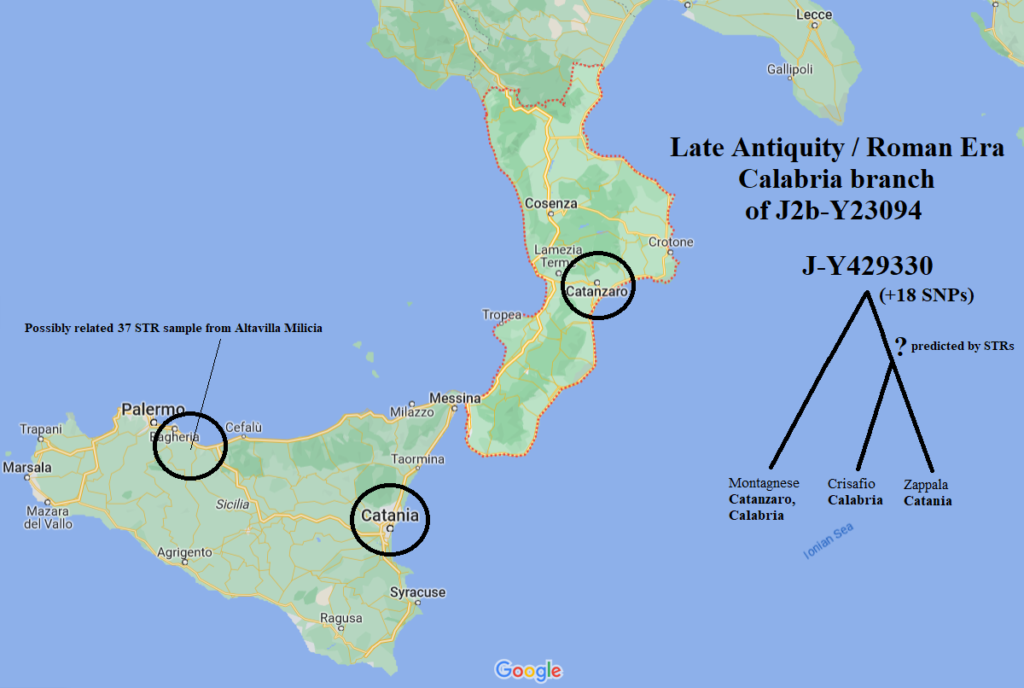Recently, Flor Veseli has determined that a Big Y sample tracing descent to a Montagnese from Catanzaro shares 19 SNPs with a recently completed WGS-tested sample who traces his male line to a Zappala from Piedemonte Etneo, Catania, Sicily (YF115514 in J-Y23094). Flor estimates that their Most Recent Common Ancestor may have lived around 1400-1800 years ago.
Shared SNPs between N107712 and YF115514:
4178106 T>C FTB42231
7284594 C>G FTB32612
11339038 C>T Y429330
11831474 G>A FTB33010
11917421 C>G FTB33047
12263784 G>C FTB33139
12286351 G>A FTB33142
14578701 A>T Y196466 / FT267136
14593825 C>T FTB33559
15065655 C>A FTB33641
16806983 G>A FTB33949
17181561 G>A FT353238
17338855 T>C FTB34075
18961030 G>T FTB34129
20067908 G>C
20362304 G>C FTB34359
20747482 C>T FT299125
20982356 A>T FTB34475
22349923 C>T FTB42500
In January 2023 I had previously identified another man from Calabria descending from Crisafio to be related to Montagnese based on sharing several rare STR alleles in the set of 67 STRs compared. You can see their STR comparison in the article – J2b-YP26 Ionian Sea branch of J2b-Y23094 now confirmed in Sicily
I also discussed the preliminary findings in a YouTube video – Two NGS Tests Recently Ordered for J2b-Y23094 from Sicily
It turns out that Zappala from Catania shares four of these rare STR alleles.
| STR | Ancestral | Derived | Mutation Rate* (years) |
| DYS568 | 11 | 10 | 76262 |
| DYS460 | 11 | 10 | 15052 |
| DYS390 | 24 | 23 | 11635 |
| DYS439 | 12 | 13 | 9377 |
*Note that the mutation rate indicated is the rate for any mutation to occur from the ancestral state, not actually the probability to mutate from Ancestral to Derived (my study aggregated all mutations together to compute a mutation rate).
Zappala – Crisafio may form subcluster

Due to shared rare alleles and having a lower genetic distance to one another, Zappala and Crisafio may be more closely related to one another than they are to Montagnese.
However, there is the complication that both Crisafio and Montagnese both have DYS640 = 12 -> 13 while Zappala has ancestral 12. Taken on its own, one would assume that this would indicate that Crisafio and Montagnese were more closely related, having inherited 12 -> 13 from a more recent common ancestor.
Because not enough subclades on the YFull YTree were computed as having DYS640 = 13, I did not compute the mutation rate for this subclade. Based on established theory, the mutation rate for a longer allele can be expected to be higher. So there is the possibility that Zappala’s ancestors originally also shared DYS640 = 12 -> 13 but that his line alone later mutated back to 12, erasing evidence of the prior allele in his line.
If we ever get confirmation by SNP testing that Zappala and Crisafio really are more closely related to each other than they are to Montagnese (as I predict), then Zappala’s mutation from ancestral DYS640 = 13 back down to 12 would, I think, be the most harmonious explanation because the mutation rate of DYS640 = 13 should be higher than that of DYS640 = 12 (I don’t have an estimate for what it should be).
| STR | Ancestral | Derived | Mutation Rate* (years) |
| DYS640 | 12 | 13 | 39882 |
| DYS640 | 13 | 12 | ? |
| DYS520 | 22 | 21 | 10325 |
| DYS449 | 29 | 28 | 5732 |
Late Antiquity Migration Most Likely
If the migration to Calabria happened after the MRCA of these men lived, then it would had to have involved at least two descendants co-migrating to Calabria. Given that historically attested migrations of Albanians to Calabria are about 1000 years after the estimated TMRCA of this line (1400 to 1800 ybp by Flor) and that this line has no living relatives found in the highly sampled population of Albania, we consider it unlikely that this line represents Arbëreshë migrants from the Middle Ages.
A more harmonious explanation is that a single ancestor or clan migrated in a single event during Late Antiquity.
It is also possible that the ancestor of this line had already been living in Calabria for some time before one of his descendants finally was able to diversify the line around 1400 to 1800 years ago. There is no circumstantial evidence yet in the form of another more distant relative to this line from someplace else to contradict this. If someone else is found to split their subclade, being positive for all but a few SNPs, and does not himself trace descent to Calabria, then we may rule out a much earlier migration to Calabria as less probable than it otherwise may be due to general circumstantial evidence.
These posts are the opinion of Hunter Provyn, a haplogroup researcher in J-M241 and J-M102.